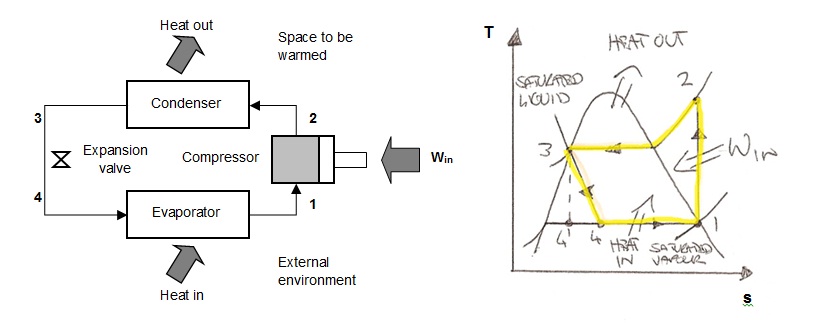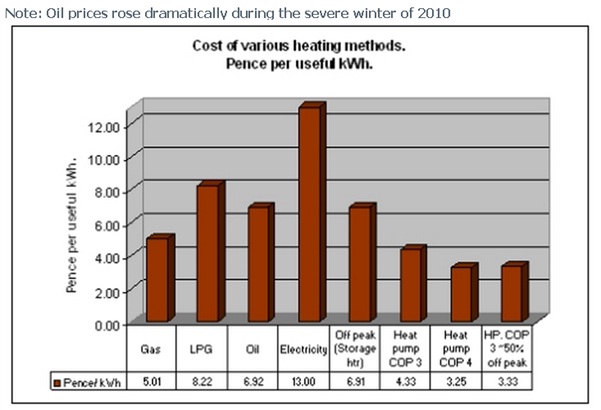Ground Source Heat Pumps (GSHP) Literature Review
Introduction
Heat pumps are reverse refrigerators that instead of removing heat from a cool environment to an external warmer environment they remove heat from an external warm environment to a cooler environment. Shown in the image below is an ideal vapour compression heat pump cycle schematic, and the corresponding T-s diagram.

The vapour - compression refrigeration cycle is the most commonly used cycle in heat pumps, air-conditioning and refrigeration. Shown in the table below is a description of the key components, related process and state on the T-s diagram.

The refrigerant enters the compressor at state 1 as a saturated vapour and is compressed isentropically to the condenser pressure. During this process the temperature of the refrigerant increases to substantially.
The refrigerant then enters the condenser at state 2 as a superheated vapour, and rejects its heat to the environment through heat transfer in the condenser. In a heat pump system this has the effect of raising the temperature of the space to be heated.
At state 3 the refrigerant is a saturated liquid, as its temperature has dropped. It then goes through an expansion valve which lowers the refrigerant temperature and turns the refrigerant into a low temperature liquid vapour mixture.
At state 4 the refrigerant enters the evaporator as low quality saturated vapour With the refrigerant at a low temperature and pressure, heat is absorbed from the external environment which results in the temperature of the refrigerant increasing and vaporising.
Source 1.
Heat pump applications
There is a diverse range of domestic heat pump applications with differing heat sources and supply options, shown below is an outline of the Ground source (geothermal) heat pumps (GSHP) application.
Ground source (geothermal) heat pumps (GSHP)
Using water as the source of heat is considered the best source of heat and the water is typically taken from a nearby lake as the temperature is stable, and is usually above 10°C. This water can be fed directly to the evaporator if contaminants have been dealt with 2.Alternatively a bore hole can be sunk into the ground to take advantage of higher water temperatures present at a deeper depth; however this option is more costly.Another form of GSHP is to embed tubing in the earth at a suitable depth to provide an adequate source temperature of 5 to 10°C. This from of GSHP is typically implemented in heating only systems 2.
The benefits of GSHP are that if they are properly installed and maintained they can last for up to 40 years, and overtime provide a low cost heating solution. The drawbacks of GSHP are that the cost is higher than other types of heat pumps and their implementation is dependant on having a heat source close by, and to have one that can deliver a suitable level of heat. The disruption and mess of a GSHP installation has to be taken into account, especially for large scale systems.
Are heat pumps a renewable technology?
Heat pumps can be considered a renewable technology because as shown in the domestic heat pump application section there are heat pump technologies that derive their heating source from renewable sources which include solar and various types of water GSHP.
Ultimately all heat pumps require some electricity to perform their heating cycle, and unless the electricity itself is generated through renewable means there will still be an environmental impact of producing the electricity.
However a key fact about heat pumps is that they require less energy to heat a house and they don't directly consume carbon rich fuel. Importantly as pointed out a key consideration when designing a heat pump installation is to insulate the domestic dwelling which further reduces the amount of energy used to het the home.
Importantly as shown below the lower running costs of heat pumps means that the amount of energy required to heat a domestic dwelling will be less than other heating methods, which results in lower emissions.

Source 3.
References
1. Cengel, Y.A. & Boles, M.A., 2007. Thermodynamics (SI units): An Engineering Approach. 6th ed. McGraw-Hill Higher Education.
2. Hundy, G.H., Trott, A.R. & Welch, T.C., 2008. Refrigeration and Air-Conditioning. Oxford: Butterworth-Heinemann.
3. Cantor, J., 2011. John Cantor Heat Pumps. [Online] Available at: http://www.heatpumps.co.uk/viability.htm.
© University of Strathclyde